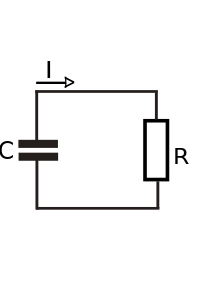
A | B | C | D | E | F | G | H | CH | I | J | K | L | M | N | O | P | Q | R | S | T | U | V | W | X | Y | Z | 0 | 1 | 2 | 3 | 4 | 5 | 6 | 7 | 8 | 9
This article needs additional citations for verification. (March 2018) |
| Linear analog electronic filters |
|---|
A resistor–capacitor circuit (RC circuit), or RC filter or RC network, is an electric circuit composed of resistors and capacitors. It may be driven by a voltage or current source and these will produce different responses. A first order RC circuit is composed of one resistor and one capacitor and is the simplest type of RC circuit.
RC circuits can be used to filter a signal by blocking certain frequencies and passing others. The two most common RC filters are the high-pass filters and low-pass filters; band-pass filters and band-stop filters usually require RLC filters, though crude ones can be made with RC filters.
Introduction
There are three basic, linear passive lumped analog circuit components: the resistor (R), the capacitor (C), and the inductor (L). These may be combined in the RC circuit, the RL circuit, the LC circuit, and the RLC circuit, with the acronyms indicating which components are used. These circuits, among them, exhibit a large number of important types of behaviour that are fundamental to much of analog electronics. In particular, they are able to act as passive filters. This article considers the RC circuit, in both series and parallel forms, as shown in the diagrams below.
Natural response

The simplest RC circuit consists of a resistor and a charged capacitor connected to one another in a single loop, without an external voltage source. Once the circuit is closed, the capacitor begins to discharge its stored energy through the resistor. The voltage across the capacitor, which is time-dependent, can be found by using Kirchhoff's current law. The current through the resistor must be equal in magnitude (but opposite in sign) to the time derivative of the accumulated charge on the capacitor. This results in the linear differential equation
where C is the capacitance of the capacitor.
Solving this equation for V yields the formula for exponential decay:
where V0 is the capacitor voltage at time t = 0.
The time required for the voltage to fall to V0/e is called the RC time constant and is given by,[1]
In this formula, τ is measured in seconds, R in ohms and C in farads.
Complex impedance
The complex impedance, ZC (in ohms) of a capacitor with capacitance C (in farads) is
The complex frequency s is, in general, a complex number,
where
- j represents the imaginary unit: j2 = −1,
- σ is the exponential decay constant (in nepers per second), and
- ω is the sinusoidal angular frequency (in radians per second).
Sinusoidal steady state
Sinusoidal steady state is a special case in which the input voltage consists of a pure sinusoid (with no exponential decay). As a result, and the impedance becomes
Series circuit

By viewing the circuit as a voltage divider, the voltage across the capacitor is:
and the voltage across the resistor is:
Transfer functions
The transfer function from the input voltage to the voltage across the capacitor is
Similarly, the transfer function from the input to the voltage across the resistor is
Poles and zeros
Both transfer functions have a single pole located at
In addition, the transfer function for the voltage across the resistor has a zero located at the origin.
Gain and phase

The magnitude of the gains across the two components are
and
Antropológia
Aplikované vedy
Bibliometria
Dejiny vedy
Encyklopédie
Filozofia vedy
Forenzné vedy
Humanitné vedy
Knižničná veda
Kryogenika
Kryptológia
Kulturológia
Literárna veda
Medzidisciplinárne oblasti
Metódy kvantitatívnej analýzy
Metavedy
Metodika
Text je dostupný za podmienok Creative
Commons Attribution/Share-Alike License 3.0 Unported; prípadne za ďalších
podmienok.
Podrobnejšie informácie nájdete na stránke Podmienky
použitia.
www.astronomia.sk | www.biologia.sk | www.botanika.sk | www.dejiny.sk | www.economy.sk | www.elektrotechnika.sk | www.estetika.sk | www.farmakologia.sk | www.filozofia.sk | Fyzika | www.futurologia.sk | www.genetika.sk | www.chemia.sk | www.lingvistika.sk | www.politologia.sk | www.psychologia.sk | www.sexuologia.sk | www.sociologia.sk | www.veda.sk I www.zoologia.sk













